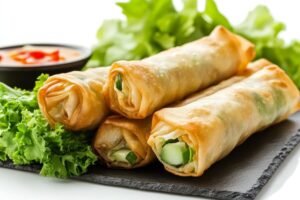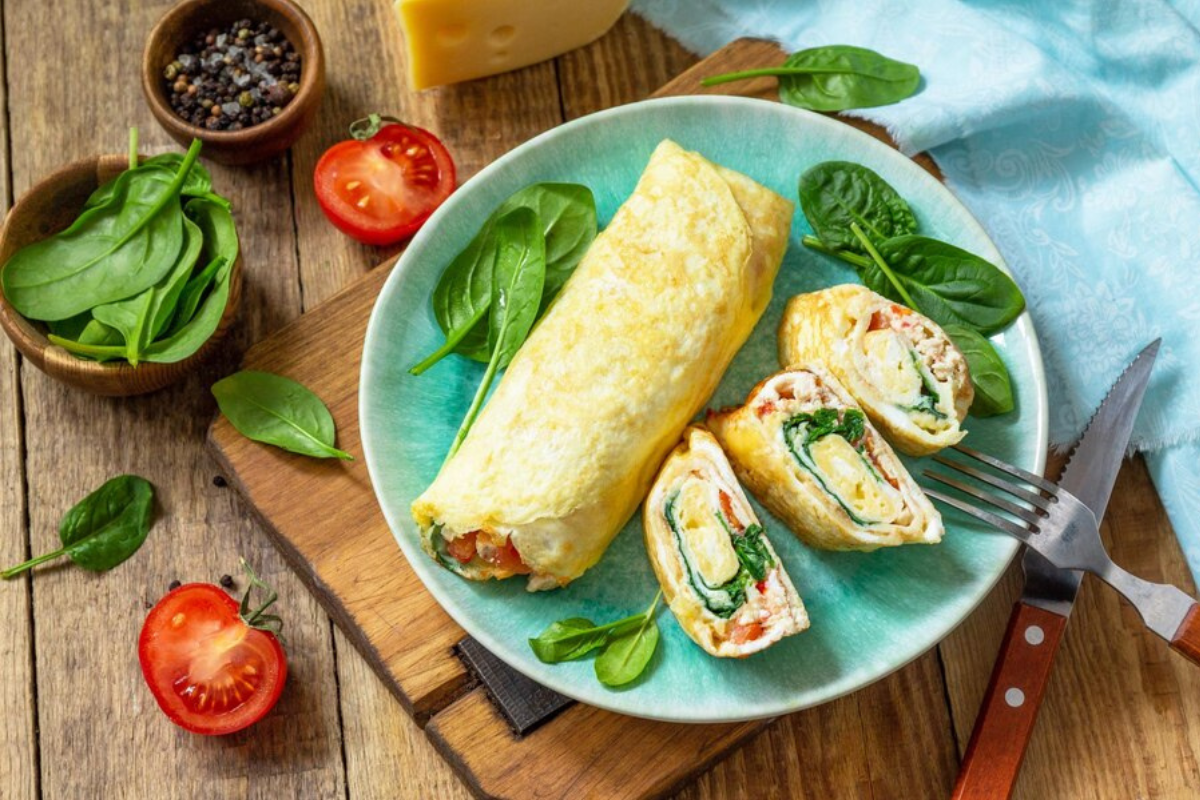Egg rolls are a beloved appetizer that many of us enjoy, especially when dining at Chinese restaurants or ordering takeout. They offer a deliciously crispy exterior filled with a savory mixture of vegetables, meats, and spices. However, if you follow a gluten-free diet, you might have asked yourself: “Are egg rolls gluten-free?”
In this in-depth guide, we’ll explore everything you need to know about egg rolls, gluten, and how to make or buy egg rolls that are safe for people with gluten sensitivities. Whether you’re new to the gluten-free lifestyle or simply looking for answers, this article has you covered.
What Are Egg Rolls ?
Before diving into whether or not egg rolls are gluten-free, let’s first define what an egg roll is. Egg rolls are a popular dish in American Chinese cuisine, typically consisting of a wheat-based wrapper filled with a mixture of:
- Vegetables like cabbage, carrots, and bean sprouts.
- Meat, commonly pork, shrimp, or chicken.
- Seasonings such as garlic, ginger, and soy sauce.
The filled wrapper is then deep-fried until crispy, making it a savory, crunchy snack or appetizer. Egg rolls are usually served with dipping sauces like soy sauce, sweet and sour sauce, or hot mustard.
However, the very components that make egg rolls so delicious also make them a potential concern for anyone following a gluten-free diet. The wheat in the wrapper and the soy sauce used in the filling are the primary sources of gluten.
Key Ingredients in Traditional Egg Rolls
Egg rolls typically contain the following ingredients, which are critical to understand when determining whether or not they are gluten-free:
- Wheat-Based Wrappers: Traditional egg roll wrappers are made from wheat flour, which is a no-go for gluten-free eaters.
- Soy Sauce: Most commercial soy sauces contain wheat. Even if the wrapper is gluten-free, the filling could still be problematic if it’s flavored with soy sauce.
- Meats and Vegetables: While the meats and vegetables used in egg rolls don’t naturally contain gluten, cross-contamination or hidden gluten in sauces can pose a risk.
The Role of Gluten in Egg Rolls
Gluten is a protein found in wheat, barley, and rye, and it’s what gives dough its elasticity and structure. When it comes to egg rolls, gluten is primarily present in the wheat-based wrappers. The presence of gluten makes egg rolls off-limits for individuals with celiac disease, gluten intolerance, or gluten sensitivities.
For people with these conditions, even trace amounts of gluten can lead to uncomfortable or harmful symptoms. As a result, understanding where gluten hides in egg rolls is critical to maintaining a gluten-free lifestyle.
Are Store-Bought Egg Rolls Gluten-Free ?

Unfortunately, most store-bought egg rolls are not gluten-free. The majority of frozen or pre-made egg rolls found in supermarkets use traditional wheat-based wrappers, which means they contain gluten. Additionally, many brands of frozen egg rolls also include soy sauce or other flavorings that contain gluten.
Even if the label doesn’t specifically list “wheat” or “gluten” in the ingredients, there could still be hidden sources of gluten. Here are some common culprits to watch out for:
- Modified food starch: This can sometimes be derived from wheat.
- Soy sauce: Often contains wheat, unless specified as gluten-free.
- Seasonings: Some spice blends may include gluten-containing additives.
Gluten-Free Egg Roll Brands
The good news is that there are now some gluten-free egg rolls available for purchase, both in the freezer aisle and from specialty brands. Some of the top gluten-free egg roll options include:
- Feel Good Foods Gluten-Free Egg Rolls: This brand offers a variety of gluten-free egg rolls made with rice flour-based wrappers. They are available in several flavors, including chicken, vegetable, and pork.
- Lucky Foods Veggie Spring Rolls: While technically a spring roll, Lucky Foods’ offering provides a similar experience to an egg roll but is made with gluten-free rice paper wrappers.
- Trader Joe’s Spring Rolls: Though not marketed as “egg rolls,” Trader Joe’s spring rolls are gluten-free and use rice paper wrappers, offering a lighter and gluten-free alternative.
When buying gluten-free egg rolls, always double-check the label for potential allergens and ensure the product is certified gluten-free. This certification ensures the food has been tested to meet gluten-free standards and is safe for those with celiac disease or gluten intolerance.
Making Gluten-Free Egg Rolls at Home.
If you’re unable to find gluten-free egg rolls in stores or prefer homemade options, making gluten-free egg rolls at home is entirely possible. While traditional egg rolls use wheat-based wrappers, there are several gluten-free alternatives you can use instead.
Ingredients for Gluten-Free Egg Rolls
Here’s what you’ll need to make gluten-free egg rolls from scratch:
- Gluten-free wrappers: You can purchase gluten-free egg roll wrappers from specialty stores or make your own using a combination of rice flour, tapioca starch, and xanthan gum.
- Filling: The filling can be the same as traditional egg rolls—cabbage, carrots, bean sprouts, and a choice of meat like pork or shrimp.
- Gluten-free soy sauce: Instead of using regular soy sauce, opt for tamari, which is a gluten-free version of soy sauce.
- Oil for frying: Use a neutral oil like vegetable oil or peanut oil for frying the egg rolls.
Step-by-Step Recipe
Follow these steps to make your own delicious :
- Prepare the filling: In a large skillet, cook your choice of protein (pork, shrimp, or chicken) until fully cooked. Remove the protein and set it aside. In the same skillet, sauté garlic, ginger, cabbage, carrots, and any other vegetables of your choice. Add gluten-free soy sauce (tamari) and cook until vegetables are tender. Combine the meat with the vegetables and set the filling aside to cool.
- Prepare the wrappers: If you’re using store-bought gluten-free wrappers, skip this step. Otherwise, combine rice flour, tapioca starch, xanthan gum, and a pinch of salt. Gradually add warm water until a dough forms. Roll the dough out into thin sheets and cut them into squares.
- Assemble the egg rolls: Place a spoonful of filling in the center of each wrapper. Fold the bottom corner up over the filling, fold the sides in, and roll tightly. Use water to seal the edges of the wrapper.
- Fry the egg rolls: Heat oil in a deep frying pan or pot to 350°F (175°C). Fry the egg rolls in batches until they are golden brown and crispy. Remove and drain on paper towels.
- Serve: Serve the gluten-free egg rolls with your favorite dipping sauces, such as sweet chili sauce, gluten-free soy sauce, or hot mustard.
Cross-Contamination and Gluten-Free Safety
While making your own gluten-free egg rolls at home reduces the risk of gluten exposure, it’s still important to be aware of cross-contamination. Cross-contamination occurs when gluten comes into contact with gluten-free ingredients, utensils, or cooking surfaces.
Here are some tips to avoid cross-contamination:
- Use dedicated utensils: Make sure that the knives, cutting boards, and frying pans you use for gluten-free cooking are not shared with gluten-containing foods.
- Separate cooking spaces: If possible, use a separate area of the kitchen for preparing gluten-free foods to minimize the risk of gluten contamination.
- Clean thoroughly: Always clean surfaces, appliances, and utensils before cooking to ensure that no traces of gluten remain.
- Check ingredients: Always read labels carefully and opt for certified gluten-free products whenever possible.
Are Spring Rolls a Gluten-Free Alternative ?
For those who want to enjoy a similar appetizer but avoid the risk of gluten altogether, spring rolls might be a good alternative. Spring rolls, particularly those made with rice paper wrappers, are often naturally gluten-free. These wrappers are made from rice flour and water, making them safe for gluten-sensitive individuals.
However, it’s important to note that not all spring rolls are gluten-free. Some versions may use wheat-based wrappers or contain gluten in the form of sauces or fillers. Always check the ingredients to ensure that the spring rolls you’re eating are truly gluten-free.
If you’re looking to make your own gluten-free spring rolls, the process is very similar to making gluten-free egg rolls. Simply use rice paper wrappers in place of egg roll wrappers and fill them with your choice of meats, vegetables, and gluten-free seasonings.
Gluten-Free Dipping Sauces
One of the best parts of eating egg rolls is the dipping sauce. However, many traditional dipping sauces contain gluten, especially those made with soy sauce. Here are some gluten-free dipping sauce alternatives to pair with your homemade the recipe:
- Gluten-Free Soy Sauce (Tamari): Tamari is a wheat-free soy sauce that provides the same savory flavor without the gluten. It pairs perfectly with egg rolls and other Asian-inspired dishes.
- Sweet Chili Sauce: Many sweet chili sauces are naturally gluten-free, but it’s always a good idea to
Conclusion
While traditional egg rolls contain gluten, there are plenty of ways to enjoy this iconic appetizer even on a gluten-free diet. Whether you choose to make your own at home or opt for spring rolls as an alternative, there’s no reason why being gluten-free should mean missing out on your favorite foods.
For more ideas on gluten-free snacks and alternatives, check out How to Cook Ground Chicken, which provides a great way to prepare the filling for your gluten-free recipe, or visit Elsa Easy Recipes for even more delicious inspirations!

